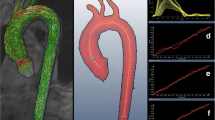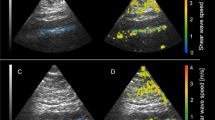Summary
The elasticity of the ascending aorta in healthy volunteers and hypertension patients were examined by using quantitative tissue velocity imaging (QTVI), and the age-related change in the ascending aortic elasticity was investigated. The anterior and posterior walls of the ascending aorta were imaged with tissue Doppler method in all the subjects and QTVI was performed. Stable curves were obtained from 173 hypertension patients and 185 healthy adults. The peak early diastolic velocity (Ve), peak late diastolic velocity (Va) and peak systolic velocity (Vs) were measured. The relation of age with these measures was assessed. The results showed that the elasticity of the ascending aorta was much lower in the hypertension patients than in normal controls (P<0.05), and the elasticity was decreased with age in both groups (P<0.05). Our results suggested that QTVI, a new non-invasive ultrasonic technique, is helpful for the assessment of the aortic elasticity in hypertension patients.
Similar content being viewed by others
References
Liang LY, Gatzka CD, Cameron JD, et al. Effect of heart rate on arterial compliance in men. Clin Exp Pharmacol Physiol, 1999,26(4):342–346
Bonithonkopp C, Jouven X, Taquet A, et al. Early carotid atherosclerosis in health middle-aged women: a follow ups study. Stroke, 1993,24(12):1837–1843
Nikitin NP, Witte KK. Application of Tissue Doppler Imaging in cardiology. Cardiology, 2004,101(1):170–184
Van de Veire NR, De Sutter J, Bax JJ, et al. Technological advances in tissue Doppler imaging echocardiography. Heart,2008,94(10):1065–1074
Nagueh SF, Bachinski LL, Meyer D, et al. Tissue Doppler imaging consistently detects myocardial abnormalities in patients with hypertrophic cardiomyopathy and provides a novel means for an early diagnosis before and independently of hypertrophy. Circulation, 2000,102(12):1346–1350
Harada K, Yasuoka K, Shimada Y, et al. Usefulness of tissue doppler imaging for assessing aortic wall stiffness in children with the Marfan syndrome. Am J Cardiol, 2004,93(8):1072–1075
Li X, Deng Y, Yang H, et al. Left ventricular regional systolic function in patient with hypertrophic cardiomyopathy by quantitative tissue velocity imaging. J Huazhong Univ Sci Technolog [Med Sci], 2006,26(1): 153–156
Pan M, Deng Y, Chang Q, et al. Detection of left ventricular regional relaxation abnormalities in patients with hypertrophic cardiomyopathy by quantitative tissue velocity imaging. J Huazhong Univ Sci Technolog Med Sci, 2004,24(2):185–188
Zhang Q, Deng Y, Liu Y, et al. Value of quantitative tissue velocity imaging in the detection of regional myocardial function in dogs with acute subendocardial ischemia. J Huazhong Univ Sci Technolog Med Sci, 28(6):727–731
Van Bortel LM, Spek JJ. Influence of aging on arterial compliance. Influence of aging on arterial compliance. J Hum Hypertens, 1998,12(9):583–586
Rafidah HM, Azizi A, Noriah MN. Blood pressure variability and arterial elasticity in hypertensive subjects. Med J Malaysia, 2006,61(2):189–198
Stefanadis C, Dernellis J, Tsiamis E, et al. Aortic stiffness as a risk factor for recurrent acute coronary events in patients with ischemic heart disease. Eur Heart J, 2000,21(5):390–396
Wolinsky H, Glagov S. Structural basis for the mechanical properties of theaorticmedia. Circ Res, 1964,14(3):400–413
Mc Dicken WN, Sutherland GR, Moran CM, et al. Color Doppler velocity imaging of the myocardium. Ultrasound Med Biol, 1992,18(6):651–654
Huang PT, Huang FG, Yang PL, et al. Evaluation of motion of abdominal aorta in healthy adults by tissue Doppler imaging. Clin J Ultrasongr, 2003,12(2):115
Yip G, Abraham T, Belohlavek M, et al. Clinical applications of strain rate imaging. J Am Soc Echocardiogr, 2003, 16(12):1334–1342
Lu Y, Huang Y, Wang Q, et al. The study of ascending aortic elasticity in the healthy subjects by quantitative tissue velocity and strain rate imaging. Zhongguo chaosheng yixue zazhi (Chinese), 2008,5(6):931–937
Lu Y, Huang Y, Yu F, et al. The study of ascending aortic elasticity in patients with hypertension by quantitative tissue Doppler and strain rate imaging. J Ultrasond Clin Med (Chinese), 2008,10(11):738–740
Zheng XZ, Ji P, Mao HW. Strain rate assessment of elasticity of aorto ascendens in hypertension patients. J Ultrsound Clin Med (Chinese), 2007,9(2): 88–90
Castro PL, Greenberg NL, Drinko J, et al. Potential pitfalls of strain rate imaging: angle dependency. Biomed Sci Instrum, 2000,36(1):197–202
Author information
Authors and Affiliations
Rights and permissions
About this article
Cite this article
Lu, Y., Deng, Y., Wang, Q. et al. Assessment of ascending aortic elasticity in hypertension patients by quantitative tissue velocity imaging. J. Huazhong Univ. Sci. Technol. [Med. Sci.] 29, 782–785 (2009). https://doi.org/10.1007/s11596-009-0622-2
Received:
Published:
Issue Date:
DOI: https://doi.org/10.1007/s11596-009-0622-2




